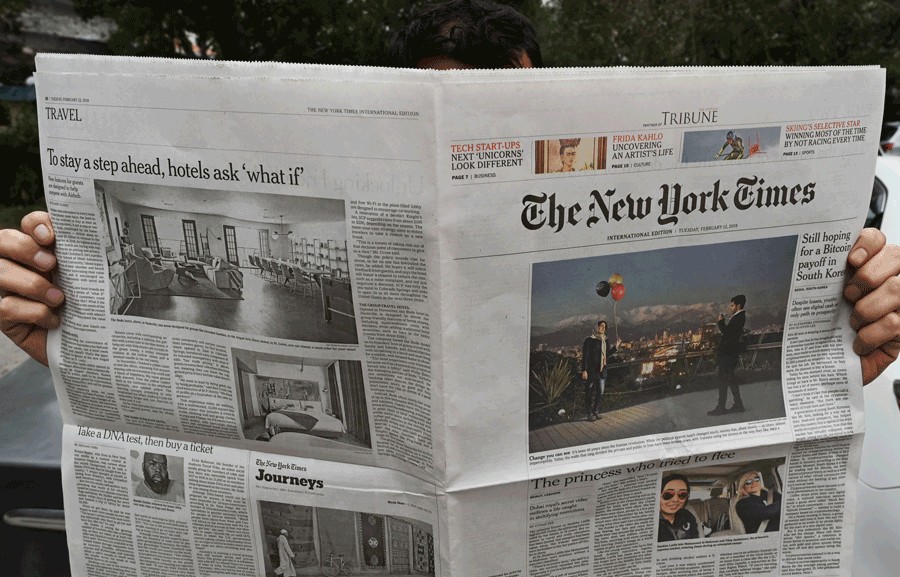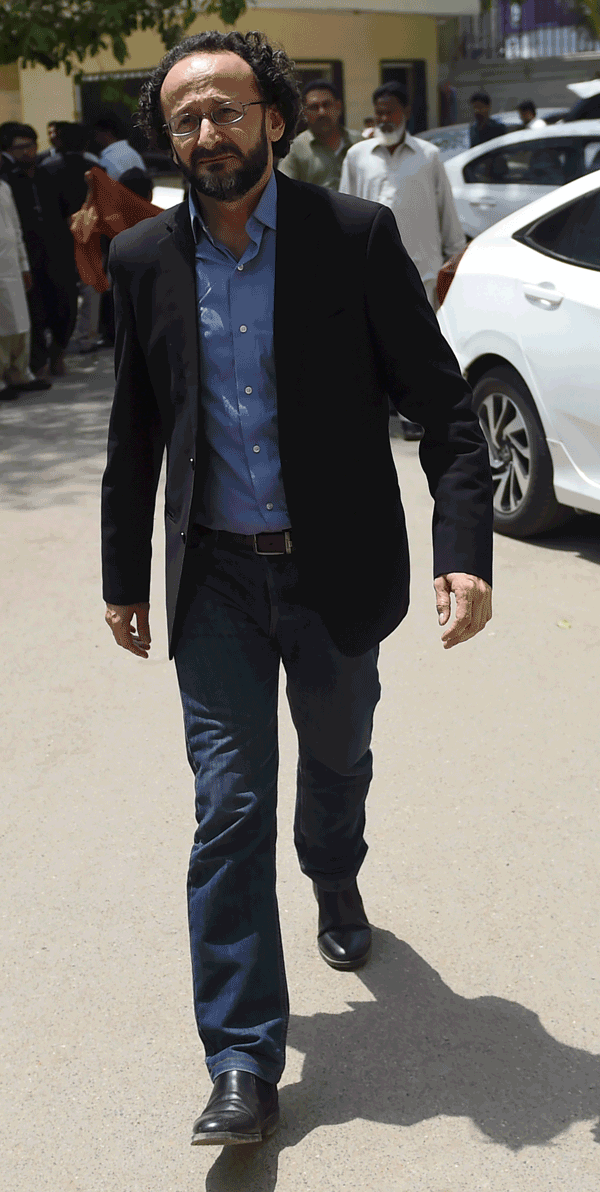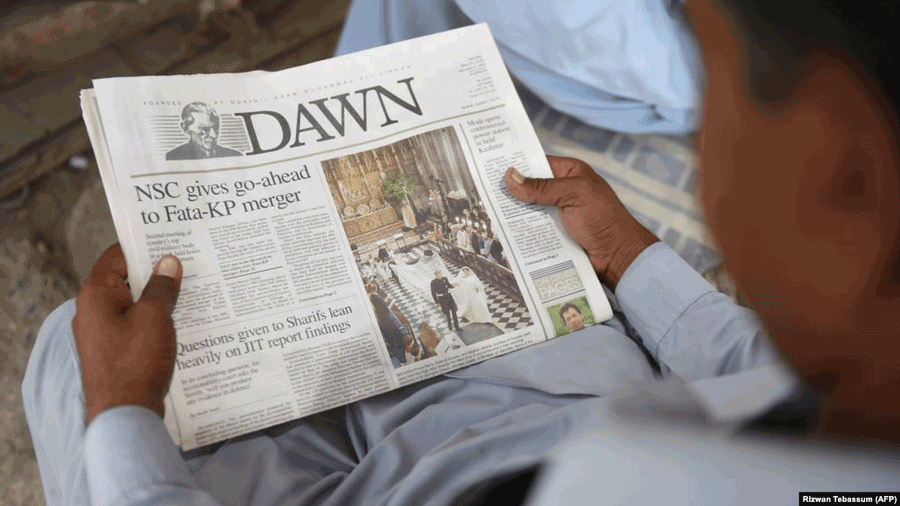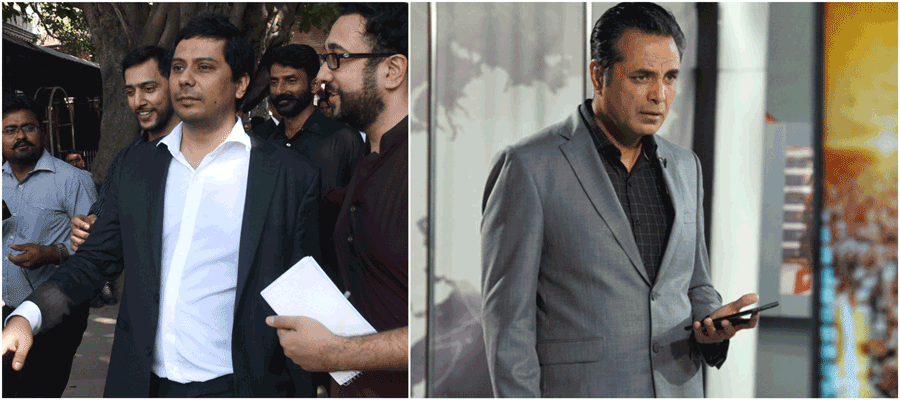The Media’s Shrinking Space
By Mazhar Abbas | Cover Story | Published 6 years ago
The assault by Pakistan Tehreek-i-Insaf’s Masroor Ali Siyal, on Karachi Press Club President, Imtiaz Farhan, in a talkshow, was essentially an attack on one of Pakistan’s most democratic institutions – the press club. It was the second incident in two weeks involving a leader of the ruling party and simply exposed their intolerance for the voice of dissent.
Ironically, in the first incident, the Minister of Science and Technology, Fawad Chaudhry (a former information minister), hit a senior journalist, Sami Ibrahim at a wedding reception. Had the prime minister, or the PTI, taken notice of the first incident, the second one could have been avoided.

Fill in the blanks: A local (censored) edition of the International New York Times.
In the past, there have been numerous incidents in which journalists were beaten up by pressure groups, and ethnic and religious groups, but I cannot recall one involving a federal minister.
Even certain institutions, it seems, cannot tolerate any dissent. Some of the Pakistan Electronic Media Regulatory Authority’s (PEMRA’s) recent decisions and the directives of the courts of law hint at the fact that a free media can be a problem for many in the state apparatus. In one of its strangest decisions, PEMRA has restricted the electronic media from airing political satire. As if this was not enough, the Islamabad High Court directed the DG PEMRA to implement its code in regard to the criticism of state institutions, including the armed forces.
Past regimes – such as that of General (R) Pervez Musharraf (2001-2008) – have often abused Article 19 of the Constitution, which provides guidelines vis-à-vis restrictions on the media.
In Pakistan there seems to be more freedom to suppress rather than express, despite the perception that the media is free to dissent. The Prevention of Electronic Crimes Act (PECA), 2016, is frequently used these days against social media activists and journalists who voice unconventional views. Journalist Shahzeb Jillani, for one, was recently charged under this law, but managed to fight and win the legal battle.

Shahzeb Jillani: In the eye of the storm.
Lawyer Molvi Iqbal Haider, who initially filed the complaint against Shahzeb Jillani, is well known in journalistic and political circles for all the wrong reasons. Haider has been used in the past for filing petitions of both a political and non-political nature.
The case was disposed off by the court after the Federal Investigation Agency (FIA) failed to bring any evidence and the FIR was subsequently cancelled. But the filing of the case made life quite traumatic for Jillani and his family and he has reportedly lost his job at a private TV channel as well.
There are at least seven other journalists facing two different kinds of inquiries under PECA, 2016. Four of them were charged by the Ministry of Interior for posting photographs of slain Saudi journalist Jamal Khashoggi on social media, at a time when the Saudi Crown Prince was on a visit to Pakistan. The journalists said they had only shown solidarity with their colleague, a Middle East Eye and The Washington Post correspondent, who was brutally killed in Turkey. Some key members of the Saudi royal family were accused of plotting the murder. The Director General, FIA, Bashir Memon says that he held an inquiry against the journalists because of a complaint received from the Secretary, Ministry of Interior. The matter is still pending.
PECA accords unprecedented powers to the (FIA) and it was used against Jillani for expressing views not liked in some quarters. The Act reminds one of the infamous Press and Publications Ordinance of the ’60s, which was replaced by another law in 1986.
Another case, under the same Act, was filed on the complaint of the owner of the Nawa-e-Waqt group, Rameza Nizami, against four journalists of her own group for some controversial remarks allegedly posted on social media. The FIA arrested but later freed the journalists, who said they had only protested against non-payment of salaries.
It appears that in the months and years to come, PECA is more likely to be used against journalists, social and rights activists rather than to curb ‘hate speech,’ the purpose for which it was ostensibly made.
PECA is an addition to dozens of other laws used to suppress the media. PEMRA was supposed to be an independent institution, but in the post-2007 emergency it was often used by political and non-political forces against TV channels.
Unlike in the past, when governments forcibly closed down newspapers and imposed complete censorship, authorities now push cable operators to take ‘problematic channels’ off air or push them further down the line, at times even without the knowledge of PEMRA. And it doesn’t end there.
In the first five months of 2019, three journalists were killed and three went missing. A young intern, the son of the Editor, PPI news agency, who went missing a couple of weeks back, had not returned till the filing of this article.
Interestingly, in the last 20 years hardly five cases of journalists’ murders out of over 120 cases, made it to the level of the superior courts. Appeals in the cases of US reporter Daniel Pearl and Geo reporter Wali Khan Babar, are pending for the last 17 and three years, respectively.
The Pakistani media faces multiple challenges, including lack of professionalism, mushroom growth of a non-journalistic breed of journalists, curbs and unwritten media advice relating to sensitive issues.
Freedom of the press or freedom of expression is more of a myth than a reality today, although the Ayub Khan and Zia-ul-Haq eras were admittedly among the worst for the press. General Musharraf’s period of emergency and even the Zulfikar Ali Bhutto’s tenure were also difficult for people who dared to dissent.
Farooq Sulehria, in his well researched book, Media Imperialism in India and Pakistan, concludes by saying, “While media imperialism has not ended, since too many examples of takeovers and media monopoly belie as much, this study shows that the leading global media have found hegemonic persuasion more cost-efficient and politically effective.”
What remains invariable and provides continuity is the element of dependency, and even there a market shift has occurred. Media globalisation has introduced new forms of dependency into the television system.
In the absence of checks and balances in the TRP race, Sulehria believes that today’s media shows signs of ‘tabloidisation,’ revolving around sex and violence on the one hand and infiltration by massive corruption on the other.
The most important and relevant part of his research is the chapter on corruption. “Corruption has emerged as a factor in the political economy in Pakistan and India. Proxy ownership of television channels, bribes, extortion money, paid news and manipulation are common practice. In the process, instead of becoming a tool in combating corruption, the media have abetted the corrupt element with grave consequences for the democratic set-up.”
This publication provides ample proof that whatever so-called ‘freedom of expression and freedom of the press,’ we have witnessed in the last few years were, by and large, ‘controlled freedom.’
With the massive mushroom growth of the media, the biggest casualty seems to be the profession itself. All this has made the real struggle for people’s right to know far more difficult as the kind of information the common man gets often revolves around ‘disinformation or misinformation.’

From embedded journalism we have now entered the era of ’embedded media.’ Its independence is now subject to ‘clearance.’ The carrot-and-stick formula has been adopted.Pakistan’s three most powerful media houses, for instance, that are in danger of financial collapse, have been told in many ways to decide whether they are ‘with us or against us.’
TV channels face the same dilemma. Concerned persons in newsrooms have been told when they should ‘mute’ or edit content through the delay system, particularly if comments or remarks are made on matters related to national security, in addition to abusive or objectionable comments.
Dawn and Geo/Jang groups are important case studies, since they are the oldest media outlets in the country. Falling out of favour, they faced a financial crunch, and were compelled to cut salaries of their employees, by 25 to 40 per cent. Even those salaries could not be paid on time. The situation in the print media is even worse. One Karachi-based daily has not paid salaries for eight months.
It is interesting that despite the existing crisis within the media, PEMRA has issued more TV licenses, and that too at hefty rates. One license for a news channel was priced at Rs 28 crores.
While the daily Dawn is still regarded as Pakistan’s truly independent and professional newspaper, it has been targeted for airing dissent and publishing stories not liked by the powers that be. Instead of taking the legal course in the aftermath of ‘Dawn leaks,’ draconian methods were adopted, like creating hurdles in the newspaper’s distribution, a blackout of the newspaper in many areas, followed by a complete unofficial ban on government advertisements.

Victims of free speech: Talat Hussain and Cyril Almeida.
International award-winning columnist, Cyril Almeida’s writing became unacceptable and he was left with no other choice but to stop writing for Dawn or for that matter, any other newspaper. Another noted journalist and anchor, Talat Hussain, faced a similar problem, as his TV show and articles did not go down well in certain quarters. In the end, the seasoned journalist had to stop writing and quit his TV programme.
Geo and Jang tried hard to recover after the attack on their anchor, Hamid Mir, and faced unprecedented pressure. They now have a strong Editorial Board to check the content of talk shows, while live shows and news have a delay system. Despite taking these measures, the group is still not fully operational in many areas in the country, for reasons other than professional.
In a bid to control the media, laws are used by the state to its advantage, but other methods are also employed, like putting pressure on cable operators to ‘off air’ one channel or the other.
The struggle for freedom of expression and freedom of the media is far more difficult today than at any time in the past, due to a division within strong unions like the Pakistan Federal Union of Journalists (PFUJ) and the All-Pakistan Newspaper Employees’ Association (APNEC). They are not willing to support media houses to put pressure on the government, until their economic grievances are addressed.
Today, among the different forms of media, social media is termed the most effective as well as the most dangerous. It’s a tool for information as well as for disinformation. If on the one hand, it is the fastest way to get information in this era of racing against time, it also curtails privacy and personal freedom, and may even endanger your life.
In countries like ours, laws are only made for ‘regulating,’ or for providing checks and balances, but in reality they are blatantly being used to suppress voices of dissent. For instance, Fawad Chaudhry, had proposed the Pakistan Media Regulatory Authority (PMRA), through which PEMRA, the Pakistan Press Council and even the PTA, could be merged, and which many believe was an attempt to control the media. In the months to come, we may see more laws to restrict freedom of expression, in the name of media regulation.
No more posts to load


